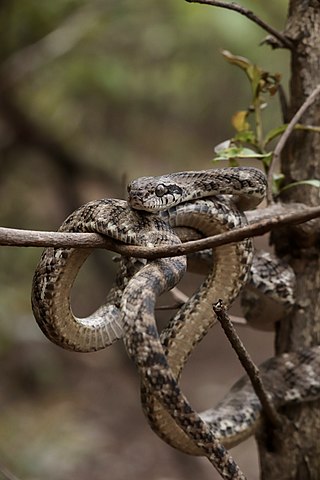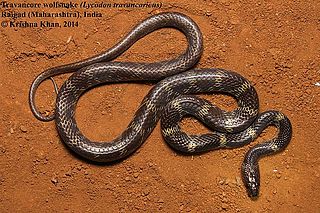
Boiga is a large genus of rear-fanged, mildly venomous snakes, known commonly as cat-eyed snakes or simply cat snakes, in the family Colubridae. Species of the genus Boiga are native to southeast Asia, India, and Australia, but due to their extremely hardy nature and adaptability, have spread to many other suitable habitats around the world. There are 38 recognized species in the genus. According to the study done by Jiří Smíd regarding Old World cat snakes, the ancestor of the cat snake originated in Africa, from where it diversified and expanded to other countries. Despite this diversity however, the different species have very similar needs in terms of temperature and precipitation.

Ahaetulla dispar, the Gunther's vine snake, is a species of tree snake endemic to the Western Ghats. It is primarily restricted to the Shola forests of the Southern Western Ghats where it is found often on high-elevation montane grasslands and the low shrub belts.

Boiga beddomei, commonly known as Beddome's cat snake, is a species of rear-fanged snake in the family Colubridae. The species is endemic to the Western Ghats of India, in Maharashtra, Gujarat and Goa states.

Boiga ceylonensis is a species of rear-fanged, mildly venomous, nocturnal, arboreal colubrid snake endemic to Sri Lanka.
Boiga dightoni, commonly known as Dighton's catsnake, the Pirmad cat snake, and the Travancore cat snake, is a species of rear-fanged mildly venomous snake in the family Colubridae. The species is endemic to the Western Ghats of India.

Boiga forsteni, also known commonly as Forsten's cat snake, is a species of mildly venomous rear-fanged snake in the family Colubridae. The species is endemic to South Asia.

The collared cat snake is a species of nocturnal, tree-dwelling, rear-fanged colubrid snake endemic to southwestern India.

Lycodon travancoricus, commonly known as the Travancore wolf snake, is a species of colubrid snake endemic to south India.

Ahaetulla, commonly referred to as Asian vine snakes or Asian whip snakes, is a genus of colubrid snakes distributed throughout tropical Asia. They are considered by some scientists to be mildly venomous and are what is commonly termed as 'rear-fanged' or more appropriately, opisthoglyphous, meaning their enlarged teeth or fangs, intended to aid in venom delivery, are located in the back of the upper jaw, instead of in the front as they are in vipers or cobras. As colubrids, Ahaetulla do not possess a true venom gland or a sophisticated venom delivery system. The Duvernoy's gland of this genus, homologous to the venom gland of true venomous snakes, produces a secretion which, though not well studied, is considered not to be medically significant to humans.

Boiga flaviviridis, the yellow-green cat snake, is a species of mildly venomous, rear-fanged snake of the family Colubridae, which is found in India. It is a rear fanged, nocturnal, arboreal species of snake that probably feeds on lizards, frogs and small birds. It was first described in 2013.

Proahaetulla is a monotypic genus of snake in the family Colubridae. It contains only one species, the keeled vine snake, which is endemic to the Western Ghats of India. Its natural habitat is montane rainforests of southern Western Ghats.

Xylophis mosaicus, the Anamalai wood snake, is a species of snake in the family Pareidae. It is endemic to the Western Ghats of India.

Lycodon deccanensis, the Deccan wolf snake, is a species of nocturnal, non-venomous colubrid snake species endemic to southern India. It was previously mistaken for another related species, Lycodon travancoricus, but later taxonomic studies revealed its distinctiveness.

The northern Western Ghats vine snake is a species of tree snake endemic to the northern Western Ghats of India.

Farnsworth's vine snake is a species of tree snake endemic to the central Western Ghats of India.

The Malabar vine snake, is a species of tree snake endemic to the southern portion of the central Western Ghats of India.

Wall's vine snake is a species of tree snake endemic to the southern Western Ghats of India.

The Travancore vine snake, is a species of tree snake endemic to the southern Western Ghats of India.

The Indian vine snake or long-nosed vine snake is a species of diurnal, mildly venomous, arboreal snake distributed in the lowlands of peninsular India.Often mistakenly believed to peck out peoples' eyes, this misconception has led to widespread wanton killing of this species.

Ahaetulla sahyadrensis is a species of tree snake endemic to the Western Ghats of India. It is also reported from Bangladesh.



















